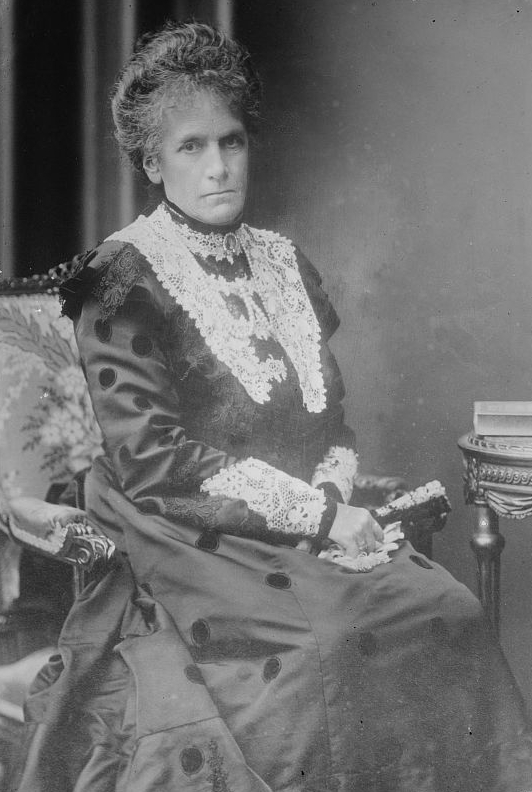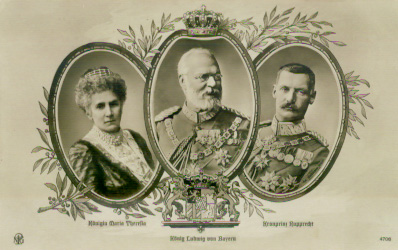by Susan Flantzer © Unofficial Royalty 2013

Maria Theresia of Austria-Este, Queen Consort of Bavaria. source: Wikipedia
Born on July 2, 1849, in Brno, Austrian Empire (now in the Czech Republic), Archduchess Maria Theresia of Austria-Este was the last Queen Consort of Bavaria and the Jacobite claimant to the British throne from 1875 until her death in 1919. She was the only child of Archduke Ferdinand Karl Viktor of Austria-Este and Archduchess Elisabeth Franziska of Austria. When Maria Theresia was only five months old, her father Archduke Ferdinand Karl Viktor, aged 28, died from typhoid fever.
In 1854, her mother Archduchess Elisabeth Franziska married a second time to her first cousin Archduke Karl Ferdinand of Austria-Teschen. From this marriage, Maria Theresia had six half-siblings:
- Archduke Franz Joseph (born and died 1855) – died in infancy
- Archduke Friedrich, Duke of Teschen (1856-1936) – married Princess Isabella of Croÿ, had issue
- Archduchess Maria Christina (1858-1929) – married King Alfonso XII of Spain, had issue
- Archduke Carl Stephan (1860-1933) – married Archduchess Maria Theresia of Austria, had issue
- Archduke Eugen (1863-1954) – unmarried
- Archduchess Maria Eleonora (born and died 1864) – died in infancy

Maria-Theresia (left) with her brother Friedrich and his wife Isabella (standing), sister Maria Christina (center), and their mother (right). source: Wikipedia
Francesco V, Duke of Modena was the current Jacobite claimant and Maria Theresia’s uncle and guardian, and it was his wish that his niece should marry Ferdinand IV, Grand Duke of Tuscany who was fourteen years older than Maria Theresia. In June 1867, Maria Theresia arrived in Vienna to attend the funeral of her friend Archduchess Mathilde of Austria who had tragically died due to burns after hiding a forbidden cigarette behind her very flammable dress. At that time, Maria Theresia met Prince Ludwig of Bavaria, a first cousin of Archduchess Mathilde of Austria, who was representing King Ludwig II of Bavaria at the funeral, and the couple fell in love.
Prince Ludwig, the future King Ludwig III of Bavaria, was the eldest child of Prince Luitpold of Bavaria, a son of King Ludwig I of Bavaria, and Archduchess Augusta of Austria. Prince Luitpold served as Prince Regent of Bavaria from 1886 to 1912, due to the mental incompetency of his nephews, King Ludwig II and King Otto. In August 1867, Francesco V, Duke of Modena and Prince Luitpold of Bavaria met in Salzburg, Austria to discuss the marriage. After initial outrage, the Duke of Modena agreed to the marriage, and the engagement was announced on October 22, 1867. Ludwig and Maria Theresia were married at the Augustinian Church, adjacent to the Hofburg Palace, in Vienna, Austria on February 20, 1868.
Maria Theresa had inherited two large estates from her father: the Sárvár estate in Hungary and the Eiwanowitz estate in Moravia (now in the Czech Republic). With the income from these estates, Ludwig and Maria Theresa purchased the Leutstetten estate in Bavaria which became quite profitable. While they lived mostly at Leutstetten, they also had a residence at the Leuchtenberg Palace in Munich, Bavaria. Their marriage was a happy one and they had thirteen children:
- Crown Prince Rupprecht (1869-1955) – married (1) Duchess Marie Gabrielle in Bavaria, had issue; (2) Princess Antonia of Luxembourg, had issue
- Princess Adelgunde (1870-1958) – married Wilhelm, Prince of Hohenzollern-Sigmaringen, no issue
- Princess Maria (1872-1954) – married Prince Ferdinando Pio of the Two Sicilies, Duke of Calabria, had issue
- Prince Karl (1874-1927) – unmarried
- Prince Franz (1875-1957) – married Princess Isabella of Croÿ, had issue
- Princess Mathilde (1877-1906) – married Prince Ludwig Gaston of Saxe-Coburg and Gotha, had issue
- Prince Wolfgang (1879-1895) – died in his teens
- Princess Hildegarde (1881-1948) – unmarried
- Princess Notburga (born and died 1883) – died in infancy
- Princess Wiltrud (1884-1975) – married Wilhelm, Duke of Urach, no issue
- Princess Helmtrud (1886-1977) – unmarried
- Princess Dietlinde (1888-1889) – died in infancy
- Princess Gundelinde (1891-1983) – married Johann Georg, Count von Preysing-Lichtenegg-Moos
In 1875, after the death of her childless uncle Francesco V, Duke of Modena, Maria Theresia became the Jacobite claimant to the British throne. After James II, King of England/James VII, King of Scots, a son of King Charles I, lost his throne via the Glorious Revolution of 1688, the Jacobite (from Jacobus, the Latin for James) movement formed. The goal of the Jacobites was to restore the Roman Catholic Stuart King James II of England/VII of Scotland and his Roman Catholic heirs to the thrones of England and Scotland. When the line of King James II of England died out, the Jacobite claims to the British throne descended from his sister Henrietta of England, Duchess of Orléans. Maria Theresia was the senior surviving descendant of Henrietta of England, Duchess of Orléans who was the youngest sister of James II/VII and the daughter of King Charles I. However, unlike the Stuart Jacobite pretenders – James II’s son James Edward Francis Stuart and James II’s grandsons Charles Edward Stuart and Cardinal Henry Benedict Stuart – none of the later Jacobite pretenders ever claimed the title.
See how the Jacobite succession arrived in the House of Austria-Este, Maria Theresia’a birth House via Henrietta of England below.
Charles I of England → his daughter Henrietta of England, Duchess of Orléans → her daughter Anne Marie d’Orléans, Queen of Sardinia → her son Carlo Emanuele III, King of Sardinia → his son Vittorio Amadeo III, King of Sardinia → his son Carlo Emanuele IV, King of Sardinia, first Jacobite Pretender from the House of Savoy → his brother Vittorio Emanuele I, King of Sardinia → his eldest surviving daughter Maria Beatrice of Savoy, Duchess of Modena → her eldest son → Francesco V, Duke of Modena → his niece Maria Theresa of Austria-Este, Queen of Bavaria
In 1912, Prince Regent Luitpold died and Ludwig became the Prince Regent for his first cousin King Otto. On November 4, 1913, the Bavarian constitution was changed to allow the Prince Regent to become King if the incapacitation of a king had lasted for ten years and there was no reasonable expectation that the incapacitated king would ever reign. On November 5, 1913, King Otto was deposed by Prince Regent Ludwig who assumed the title King Ludwig III. The Bavarian parliament gave its approval on November 6, 1913, and on November 8, 1913, King Ludwig III took the constitutional oath.

The Queen, The King, and The Crown Prince. source: Wikipedia
When World War I started in August of 1914, King Ludwig III sent an official dispatch to Kaiser Wilhelm II in Berlin to express Bavaria’s solidarity. Queen Maria Theresia appealed to Bavarian women and girls to support the country and the soldiers at the front by making packages with clothes and food for soldiers and the wounded. On February 20, 1918, in the midst of World War I, Ludwig and Maria Theresia celebrated their 50th wedding anniversary by donating ten million marks to charity.
As World War I progressed, the conditions in Bavaria deteriorated. The population was restless, soldiers were dying at the front, women had to work harder and harder in the factories, and food was always scarce. Through all of this, the Bavarian royal family remained loyal to Kaiser Wilhelm II. On November 7, 1918, King Ludwig III of Bavaria was deposed and the Republic of Bavaria was proclaimed. There were mass demonstrations throughout Munich, and Ludwig and his family fled from the Residenz Palace in Munich. He was the first of the monarchs in the German Empire to be deposed.
Ludwig and Maria Theresia first fled to Schloss Anif, near Salzburg, Austria. They returned to Bavaria and settled at Schloss Wildenwart in the village of Wildenwart about 80 kilometers southeast of Munich. Queen Maria Theresia, aged 69, died at Schloss Wildenwart on February 3, 1919, and was buried in its chapel. Shortly afterward, Ludwig, fearing he might be assassinated, fled to Hungary, later moving to Liechtenstein and Switzerland. He returned to Bavaria in April of 1920 and lived once again at Schloss Wildenwart. He remained there until September of 1921 when he took a trip to his Sárvár estate in Hungary. He died there on October 18, 1921, at the age of 76.
On November 5, 1921, Ludwig’s body was returned to Munich along with the remains of his wife. They were given a state funeral and were buried in the crypt of the Frauenkirche. Despite the abolition of the monarchy, the former King and Queen were laid to rest in the presence of the royal family, the Bavarian government, military personnel, and an estimated 100,000 spectators in the streets.

Tombs of King Ludwig III and Queen Maria Theresa in the Frauenkirche, Munich. Photo © Susan Flantzer, August 2012
This article is the intellectual property of Unofficial Royalty and is NOT TO BE COPIED, EDITED, OR POSTED IN ANY FORM ON ANOTHER WEBSITE under any circumstances. It is permissible to use a link that directs to Unofficial Royalty.
Bavaria Resources at Unofficial Royalty
